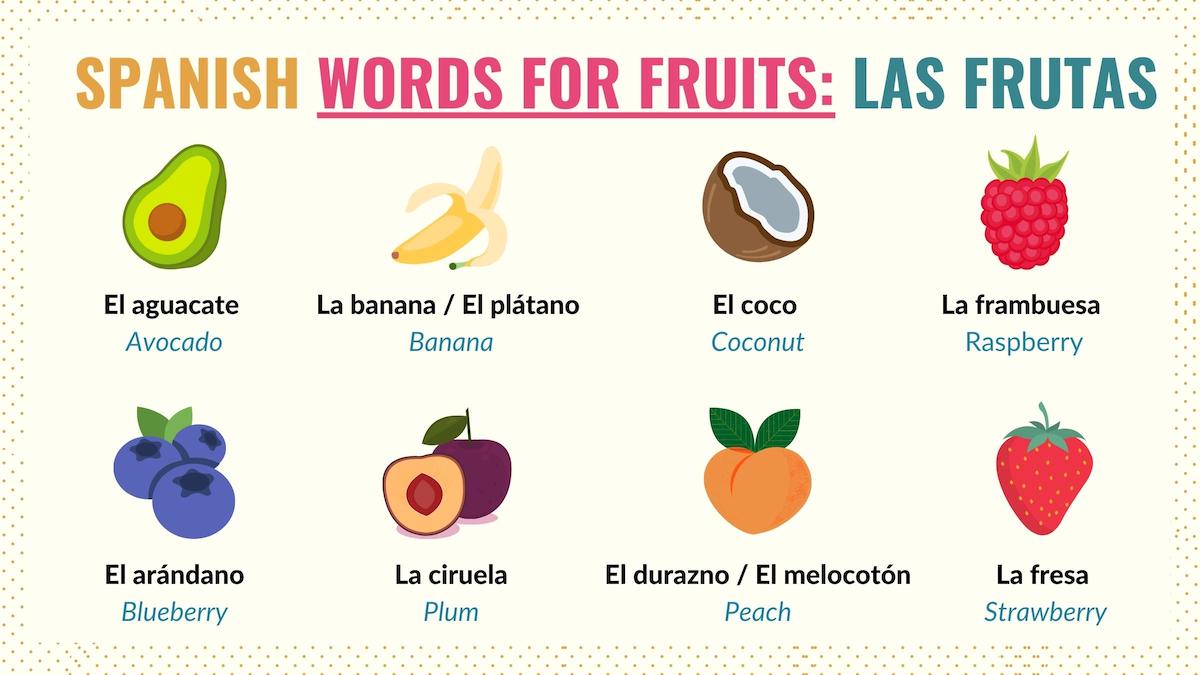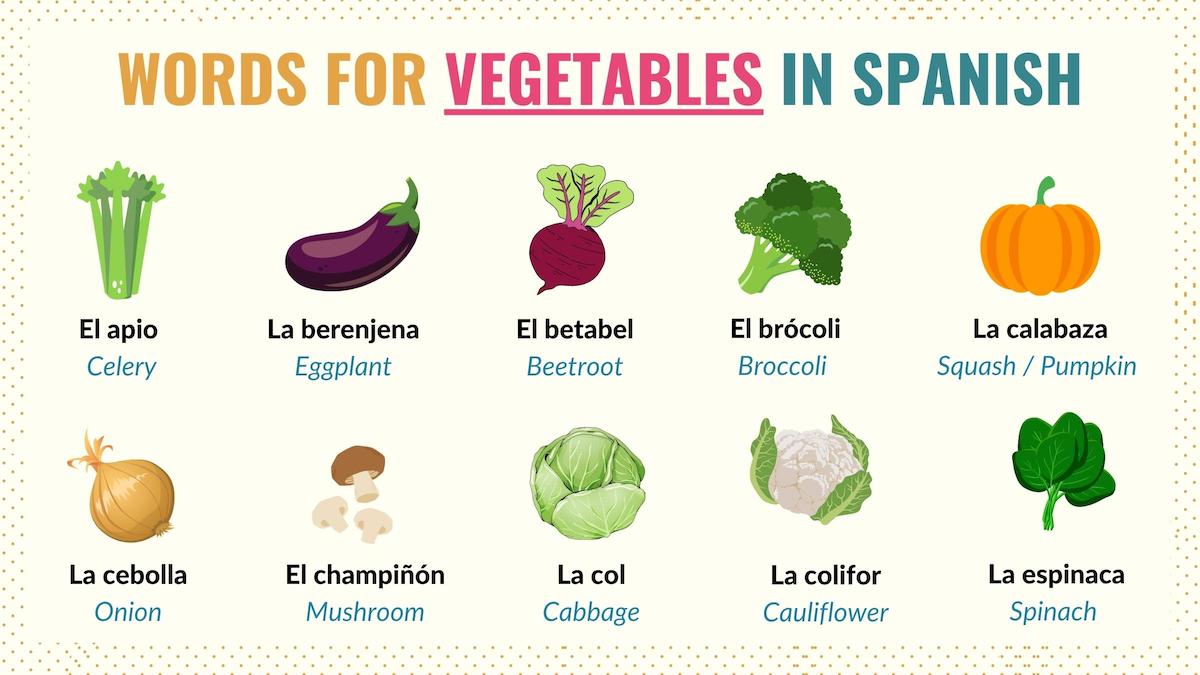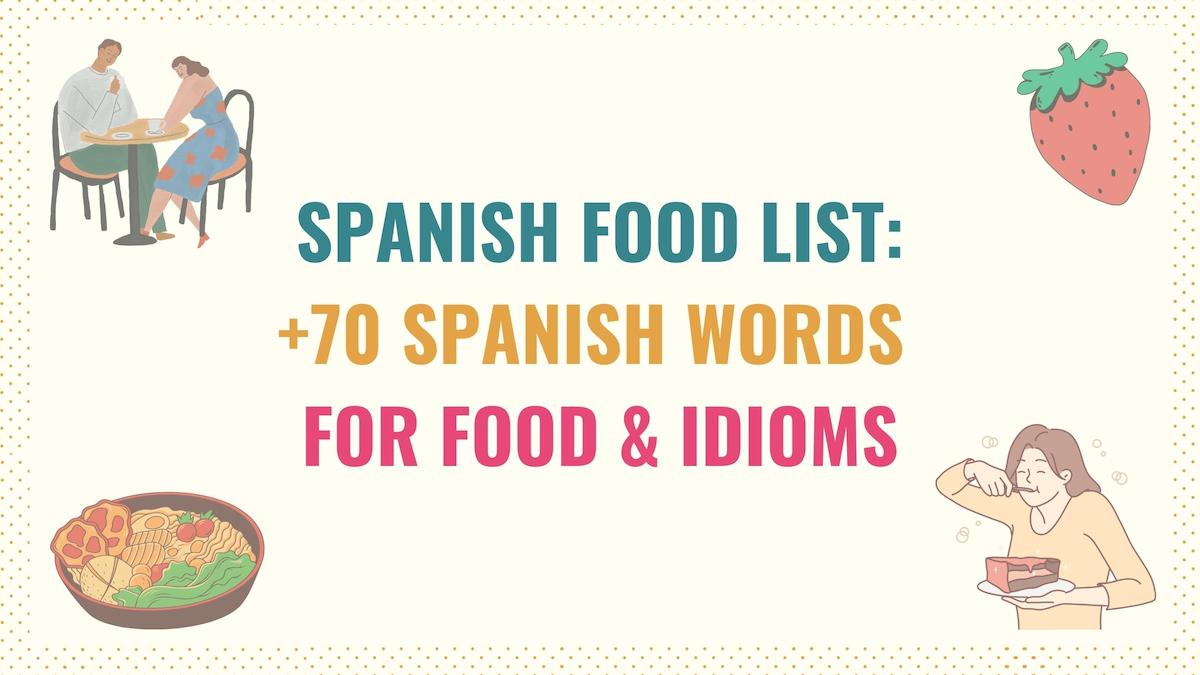Knowing words for food in Spanish can be extremely useful for your conversations. Whether you’re at a restaurant or talking about what you like to eat, this vocabulary is applied in daily life situations. So, in this Spanish food list, I’ve compiled the most common words you should know.
In addition to this vocabulary, I’ve also included common idiomatic expressions with food and recordings for you to practice the pronunciation of these terms. Here is an overview of what we’ll cover:
- List of Words for Food in Spanish
- Phrases to Talk About Food
- Food Idioms in Spanish
- Next Steps
- Downloadable PDF
Let’s get down to business!
List of Spanish Words for Food – La Comida
Below is the most common Spanish food vocabulary. For the most part, these words are used across all Spanish-speaking countries. I’ve made sure to include dialectal variations when applicable.
In such cases, the term used in Spain will appear first, followed by the food word used in Latin America.
Fruits – Las Frutas
- El aguacate: Avocado
- El arándano: Blueberry
- La banana / El plátano: Banana
- La ciruela: Plum
- El coco: Coconut
- El durazno / El melocotón: Peach
- La frambuesa: Raspberry
- La fresa: Strawberry
- La guinda / La cereza: Cherry
- La granada: Pomegranate
- El higo: Fig
- El kiwi: Kiwi
- El limón: Lemon
- La mandarina: Mandarin
- El mango: Mango
- La manzana: Apple
- El melón: Melon
- La naranja: Orange
- La papaya: Papaya
- La pera: Pear
- La piña: Pineapple
- El pomelo / La toronja: Grapefruit
- La sandía: Watermelon
- La uva: Grape

¿Quién quiere una naranja?
Who wants an orange?
Necesito más aguacate.
I need more avocado.
El mango sabe un poco ácido.
The mango tastes a bit sour.
A Stephanie no le gustan las manzanas.
Stephanie doesn’t like apples.
Take Note: Spanish food words are nouns. As a result, they have gender and plural forms. Fruit terms follow the standard rules for gender where feminine words end with an a and masculine terms with an o, u, e or i.
Vegetables – Las Verduras
- El apio: Celery
- La berenjena: Eggplant
- El betabel: Beetroot
- El brócoli: Broccoli
- La calabaza: Squash / Pumpkin
- La cebolla: Onion
- El champiñón: Mushroom
- La col: Cabbage
- La colifor: Cauliflower
- La espinaca: Spinach
- El guisante / El chícharo: Pea
- La lechuga: Lettuce
- El maíz: Corn
- La papa: Potato
- El pepino: Cucumber
- El pepinillo: Pickle
- El pimiento: Pepper
- El rábano: Radish
- El tomate*: Tomato
- La zanahoria: Carrot
*In Mexican Spanish, tomate refers to green tomatoes, whereas jitomate is the word for red tomato.

Limpia las papas, por favor.
Clean the potatoes, please.
La tortilla está hecha de maíz.
Tortilla is made of corn.
Necesitas comer más lechuga.
You need to eat more lettuce.
Take Note: In Spanish, verduras and vegetales are the words we use to say ‘vegetables’.
Meats & Seafood – La Carne y Los Mariscos
- El atún: Tuna
- El camarón: Shrimp
- El cangrejo: Crab
- La carne: Meat
- El cerdo: Pork
- El jamón: Ham
- La langosta: Lobster
- El langostino: Prawn
- Los mariscos: Seafood
- La res: Beef
- El pescado: Fish
- El pollo: Chicken
- El pulpo: Octopus
- La salchicha: Sausage
- El salmón: Salmon
- La trucha: Trout
¿Te gusta el pescado?
Do you like fish?
Tim es alérgico al camarón.
Tim is allergic to shrimp.
Mi hermana no come carne de res.
My sister doesn’t eat beef.
In Spanish, it’s common to use the structure carne de to talk about the type of meat. We do this to avoid confusing a Spanish food term with the name of the animal. Here is an example:
Me encanta la carne de cerdo.
I love pork.
Spanish dairy products & others – Productos Lácteos y otras comidas
- El aceite: Oil
- El azúcar: Sugar
- La canela: Cinnamon
- La crema: Cream
- La harina: Flour
- El huevo: Egg
- La leche: Milk
- La mantequilla: Butter
- El pan: Bread
- La pimienta: Peper
- El queso: Cheese
- La sal: Salt
- El yogur: Yogurt

No le pongas tanta sal a la comida.
Don’t put so much salt on the food.
Voy a preparar huevos con jamón.
I’m going to prepare eggs with ham.
¿Quieres mantequilla para tu pan?
Do you want butter for your bread?
Take Note: Foods for nouns can be countable or uncountable, meaning you’ll have to use different words and structures to measure them.
Additional Spanish Food Vocabulary
Now that you know the most common Spanish words for food, here is some additional vocabulary that will allow you to talk about food. This section contains other words, Spanish verbs, and expressions.
- El almuerzo: Lunch
- La cena: Dinner
- Comida chatarra: Junk food
- Comida rápida: Fast food
- Cortar: To chop
- El desayuno: Breakfast
- Disfrute su comida: Enjoy your food
- El dulce: Sweet / Candy
- Intoxicación: Food poisoning
- Para llevar: Take out
- Pedazo: Piece
- Pelar: To peel
- Picar: To mince / To chop
- El postre: Desert
- Rebanar: To slice
- La rebanada: Slice
- La receta: Recipe
- El refrigerio: Snack
- Salado: Salty
- Ser alérgico a: To be allergic to
Here are some sentences:
Quiero dos rebanadas de pizza.
I want two slices of pizza.
Jonathan es alérgico a los mariscos.
Jonathan is allergic to seafood.
Este postre está muy dulce.
This dessert is very sweet.
Bonus: Spanish Idiomatic Expressions with Food
Finally, here are some popular Spanish idioms with food that can help you sound more natural:
- Agarrar con las manos en la masa: To catch red handed
- Darle vuelta a la tortilla: To turn the tables
- En todas partes se cuecen habas: Everyone has a skeleton in the closet
- Importarle un pimiento*: Couldn’t care less
- Ir al grano: To get to the point
- Pedir peras al olmo: To expect the impossible
- Ser la cereza del pastel: To be the icing on the cake
- Ser pan comido: To be a piece of cake
Next Steps: Vocab Guides to Describe, Travel, & Order Food
To make the most out of this vocabulary, here are some steps you can take.
Spanish adjectives allow you to describe nouns. So, if you want to be more precise when using the vocabulary you just learned, you should learn some adjectives to describe food.
Most students learn food vocabulary to travel. If this is your case, I have a guide on how to order food with common expressions you can use to order Spanish dishes and communicate in this situation successfully.
Download the Spanish Food Vocabulary PDF
Talking about foods in Spanish is one of the most essential skills you need in daily conversations. I’ve created a PDF you can download for free with all the Spanish food vocabulary from this guide.



